Applications for the US Teaching Assistantship (USTA) Program must be submitted through the application portal. Before applying, please continue reading below for more information about the program.
Teach English at Austrian secondary schools
Applications for the US Teaching Assistantship (USTA) Program must be submitted through the application portal. Before applying, please continue reading below for more information about the program.
Each year, the Austrian Federal Ministry of Education (BMB) seeks recent college and university graduates interested in teaching English in Austria. Fulbright Austria (the Austrian-American Educational Commission) has been responsible for recruiting US citizens for this outstanding program since 1962. More than 4,000 US teaching assistants (USTAs) have made a difference in hundreds of thousands of young Austrians’ lives over the decades.
The objective of the BMB's teaching-assistantship program—which also brings native speakers from countries such as Spain, France, and Italy into Austrian secondary schools—is not only to expose young Austrians to native speakers, but also to arouse their interest in other cultures based on cross-cultural dialogue and personal contacts.
Fulbright Austria facilitates the placement of assistants at schools in all nine Austrian provinces under the auspices of this program, which is funded by the BMB. Teaching assistants receive a monthly salary along with medical insurance and are required to apply for the appropriate work and residence permits. Although Fulbright Austria administers this program, US teaching assistants are not Fulbright grantees, but rather salaried employees of the provincial school districts employing them. Those interested in applying for US Fulbright student awards in Austria should consult the US Fulbright student page, which includes two awards that combine teaching with the student grant.
As a US teaching assistant in Austria, you will work in one or two Austrian secondary schools, teaching 13 hours every week. Specific duties differ from school to school, but in general you can expect to:
Given that teaching assistants are placed at schools in Austrian communities large and small, each teaching assistant job in Austria is a truly unique experience. However, no matter where your assignment takes you, the ability to negotiate cultural differences and to solve day-to-day problems will be a significant asset—both in the classroom and in everyday life. Previous teaching experience is beneficial but not a requirement.
If you have at least an undergraduate degree (or are currently in your final year), have a working knowledge of German (level of proficiency in speaking, writing, and reading must be B1 or above based on the EU CEFR guidelines / “intermediate mid” or above based on ACTFL guidelines), and are interested in a career in education, Fulbright Austria encourages you to apply online to teach English in Austria.

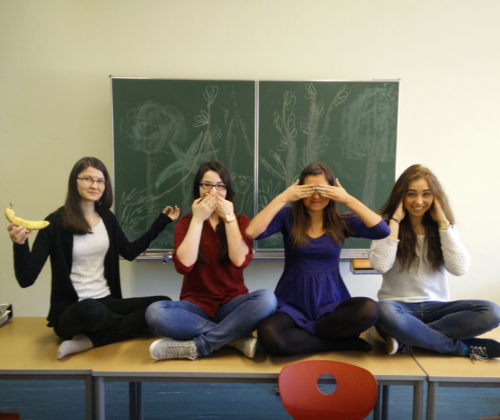 Hear no German, speak no German, see no German—and always eat your fruits and vegetables!
Hear no German, speak no German, see no German—and always eat your fruits and vegetables!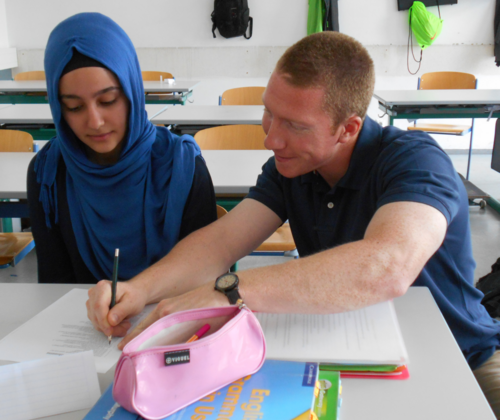
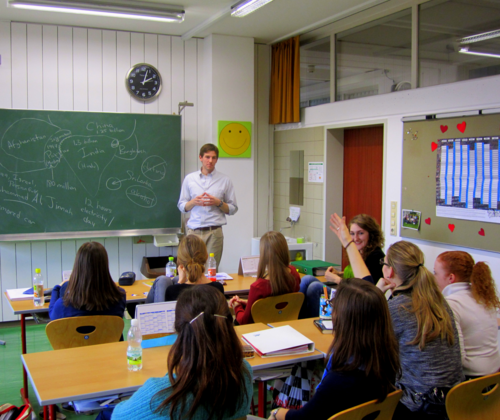
As you continue reading to delve into the official information about the USTA Program, please also be sure to check out our YouTube playlist of interviews with previous USTAs to discover more about the lived experience.

Every year, the BMB collaborates with provincial boards of education (Bildungsdirektionen) to place more than 140 teaching assistants in communities large and small in all nine Austrian provinces. The BMB places US teaching assistants in Austria at more than 200 schools and in over 1,800 classrooms, and they have contact with an estimated 40,000 students every week.
While completing your application, you can indicate your preferences in terms of province, city, and/or region. Fulbright Austria works closely with the BMB to place applicants according to their preferences and backgrounds; however, positions in urban centers such as Vienna, Salzburg, Innsbruck, and Graz are limited, so you should also be prepared to take an assignment in smaller, less metropolitan, or rural communities.
In addition to indicating your location preferences, you can also specify in which type of school you would prefer to teach English. Austria has a highly differentiated secondary-school system that is substantially different from the US, so we encourage you to review our section on the Austrian education system.
If accepted into the program, you work as a salaried English teaching assistant in Austria from 1 October to 31 May. You are also required to attend a five-day orientation the week before school starts.
If you demonstrate superior performance in your first year, you may also apply to extend your English teaching assistant job in Austria for a second year. Please note that extensions are up to the discretion of the BMB, which limits participation in the program through Fulbright Austria to two years. Second-year teaching assistants are not required to attend orientation prior to starting their second year.
With any job, knowing how much money you’ll make is vital information. As a teaching assistant in Austria, you will earn a monthly gross salary of around €2,012. Once deductions are made for your compulsory health and accident insurance and for Austrian income taxes, you end up with a net monthly salary of approximately €1,631 (about $1,922). Your monthly salary will be the only money you receive in connection with your English teaching job in Austria.
While employed under the auspices of the teaching-assistant program in Austria, you will be covered by a health and accident insurance program designed for civil servants, the BVAEB (Versicherungsanstalt öffentlich Bediensteter, Eisenbahnen und Bergbau). Coverage includes treatment for illness and injuries, eye examinations, basic dental care, some medications, therapy and/or lab work if prescribed by a physician, and hospitalization. You will be required to pay a deductible for out-patient treatment, and in-patient treatment is covered in full. Your health insurance coverage begins once you have signed your employment contract at your school. While your contract officially ends on 31 May, your insurance includes a legally mandated six-week grace period that sees you covered until 12 July. You’ll receive your electronic insurance card, or e-card, approximately one month after you start your teaching assistant job. Austria’s e-cards include your Sozialversicherungsnummer (social security number), which doctors can use to verify your coverage any time you need to seek treatment or consultation. To find out more about the conditions and extent of coverage, please consult the BVAEB’s website (in German).
I left America for the first time in my life and moved across an ocean all on my own in the pursuit of something immaterial, something I couldn't name at the time.
I suppose you could say that Fulbright Austria gave me the chance to breathe freely and for myself for the first time in my life, and I grabbed onto it with both hands—and I don't think I'll ever stop being grateful. Roland Bailey, 2019–21 USTA
Before you can access the application for teaching-assistant jobs in Austria, you first need to register by creating a profile and providing basic personal information. Once you have entered the required information, click on “Create profile.” You will then receive an email confirming registration and issuing you a username and password. Please check your spam folder if you do not receive an email in your inbox, and do not register more than once!
Enter your personal information as specified in the online application for the teaching-assistant program in Austria, paying particular attention to the mandatory fields. Please note that this information is for internal use and is only shared with parties relevant to application processing and placement; Fulbright Austria will not sell or share this information with outside parties. More information on how we handle your personal data can be found in our privacy statement.
Please provide Fulbright Austria with the city and state in which you currently live. (All official correspondence will be sent to your email address, but knowing the city and state in which you currently live will help us provide you tailored information with regard to where you can submit your application for your residence permit.)
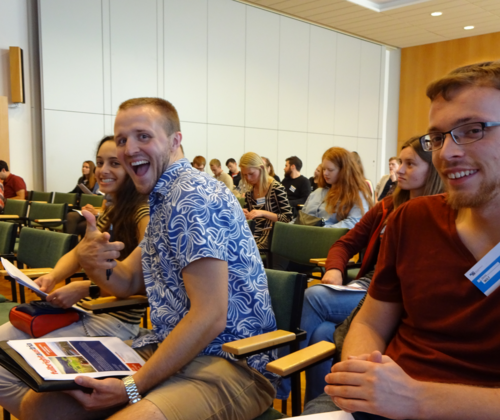 USTA orientation
USTA orientation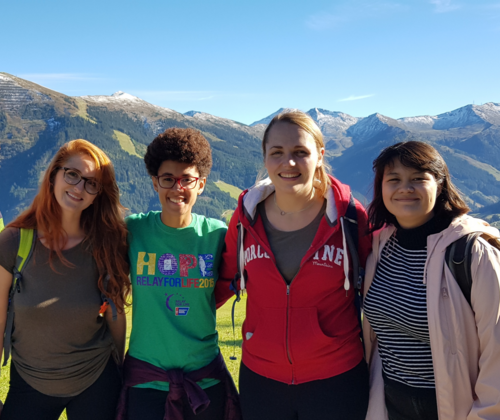 USTAs out for a hike during orientation
USTAs out for a hike during orientationWhen applying to the USTA Program, it is important to remember that not all USTAs teach English in Vienna, Salzburg, or other larger cities in this Alpine country. In fact, USTAs are placed in communities large and small, in urban and rural settings in all nine Austrian provinces.
Fulbright Austria solicits information on placement preferences during the application process in order to facilitate matching finalists as closely as possible with job assignments that best correspond to their interests. However, it is not always possible to place teaching assistants based on their preferences; as such, it is important to remain flexible and open to areas of Austria not indicated in you preferences.
When completing your online application to be a teaching assistant in Austria, you can list up to two Austrian provinces you would prefer or inform us that you do not have any particular preferences. You can also describe the general setting or region you would prefer (e.g. mountainous, rural, near a university, etc.). Again, given that the number of openings to teach English in Innsbruck, Graz, Linz, etc., are limited, we encourage you to be flexible in your preferences but will do our best to meet any preferences you indicate.
Furthermore, when it comes to teaching English at schools in Austria, there is a wide variety of secondary-school types with specialized curricula. Here too you can indicate a preference by specifying a particular type of school that best matches your interests and qualifications. Be sure to read our section on Austrian schools for more information about the various school types in Austria.
My two years as a USTA showed me the powerful role of international education and exchange in creating deeper connections between people. Julia Petron, 2020–22 USTA
In addition to uploading their CV in the “Uploads” section of the application, those interested in teaching English in Austrian schools must also complete the application section regarding general work experience, relevant work experience, and social engagement. If you do not have any experience in a particular category, you may leave it blank. If you do have experience in any of the three categories, please list the three most relevant employers/activities in each category, starting with the most recent. Include the name of your employer(s), your duties and responsibilities, the duration of employment, and the number of hours worked per week.
The following documents must be uploaded as individual PDFs (no larger than 2MB) by the 15 January application deadline:
Being accepted into the USTA Program is only the first step; upon acceptance, there are additional requirements to teach English in Austria, and these action items should be completed immediately:
You will also need to take care of the following items as soon as possible, but no later than 1 July:
Do not forget to:
As you prepare for the English teaching jobs in Austria that comprise the USTA Program, there are several things to consider and take care of before you cross the Atlantic. Below you will find useful advice that we at Fulbright Austria believe will help you prepare so that you can get the most out of your experience when you arrive to teach English in Austria. Jobs in this program start on 1 October, so be sure to start following the advice offered here as early in the summer as possible.
Start looking for housing as soon as possible. The best way to start looking for housing in Austria is to contact your Stammschule and mentor teachers. If applicable, you should also reach out to the teaching assistants currently teaching in the school(s) to which you have been assigned. In addition, Fulbright Austria provides you with a handbook that contains detailed information on other means of finding suitable housing during your time in the teaching-assistant program in Austria.
 USTAs join in the fun during Vienna's annual ball season.
© Adrian Almasan
USTAs join in the fun during Vienna's annual ball season.
© Adrian Almasan © Adrian Almasan
© Adrian Almasan USTAs are invited to events within the broader Fulbright Austria community, including the annual "Thank Fulbright – Thanksgiving" dinner.
© Adrian Almasan
USTAs are invited to events within the broader Fulbright Austria community, including the annual "Thank Fulbright – Thanksgiving" dinner.
© Adrian Almasan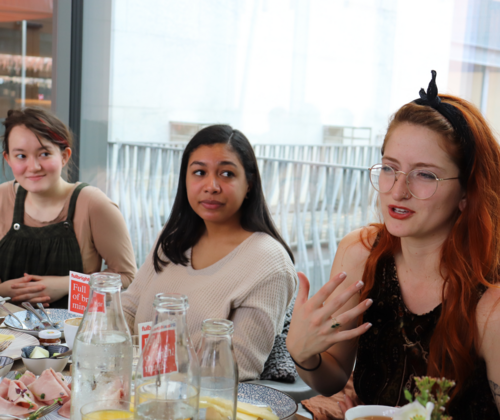 USTAs join other members of the Fulbright Austria community for brunch.
USTAs join other members of the Fulbright Austria community for brunch.The following is a list of fees and expenses that USTAs should expect to incur prior to departing and after arriving in Austria:

We know there are a lot of balls to juggle as you prepare to participate in the USTA Program; with that in mind, we've created a helpful handbook series of videos covering a range of relevant topics.

You have done a lot to get to this point, and you’ve finally arrived in the country you will call home for the next nine months. But what exactly should you do first? Below you’ll find action items that should be dealt with immediately after you arrive to teach English in Austria.
Due to the requirements set forth as part of Austria’s immigration system, USTAs are required to submit their rental contract or other proof of their intended residence in Austria when submitting their application for an Austrian residence permit. We recommend that you begin the process of securing accommodations as early as possible—particularly if your schools are in smaller parts of Austria, where it may be difficult to find suitable accommodations online. Be sure to contact current teaching assistants in your city and the mentor teachers at your school(s).
It is an opportunity for growth and development, outreach and connection, discovery and clarification, hope and love. Without Fulbright Austria, these opportunities would be very limited for me, so I am very thankful for Fulbright and the support this program receives. Ian Saner, 2019–20 USTA
The immigration authorities will ask to see your Meldezettel, so obtain one from the relevant authorities before going to pick up your residence permit. When you pick up your residence permit, the immigration authorities will ask for your Meldezettel, your passport, and any remaining fees if you did not pay in full when you submitted your residence permit application to the Austrian consulate in the US. The authorities will also take your fingerprints. In some cases, you will receive your permit immediately after submitting your fingerprints. In others, you will have to return to the office about ten days later to pick up your permit. Be sure to factor in the possibility of a ten-day wait.
One of the first things you should do after arriving is open a bank account into which the school board can deposit your monthly salary. Be sure that you open a Gehaltskonto or Girokonto, as your employer will otherwise not be able to direct-deposit your paycheck. When you open your account, inform the bank that your employer is the Bildungsdirektion responsible for your schools, and ask the bank to provide you with a document that confirms that you are the account holder and that your salary may be deposited into the account. This confirmation can come in the form of a so-called Antrag auf bargeldlose Gehaltszahlung/Bezugsanweisung or Kontoerklärung.
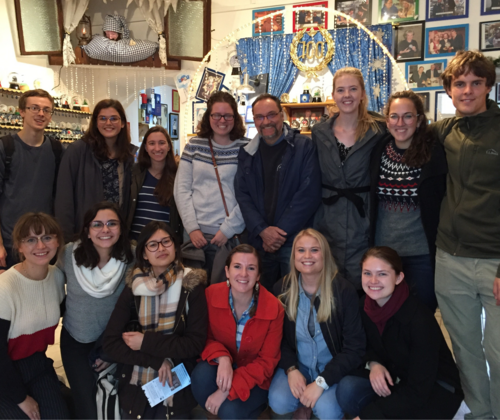 Regional advisors periodically plan events for USTAs living in the area.
Regional advisors periodically plan events for USTAs living in the area.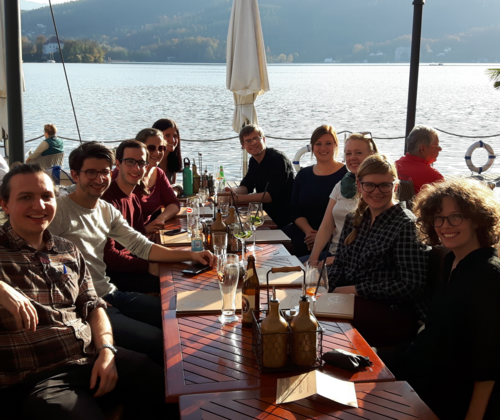 Regional USTA event in Klagenfurt
Regional USTA event in Klagenfurt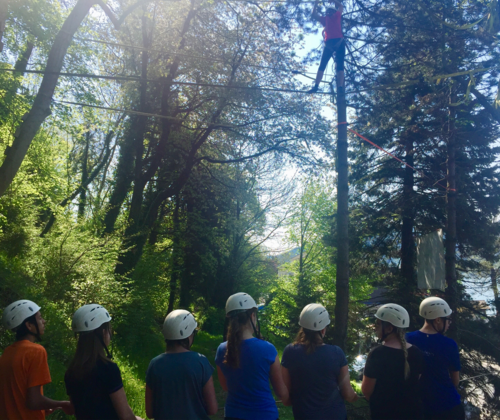 Many USTAs also get to participate in school events like sport week.
Many USTAs also get to participate in school events like sport week.
If you have additional questions, please don't hesitate to contact the USTA program officer.

USTA Program Officer
TEL. +43-1-236 7878 - 11
KHuetthaler@fulbright.at